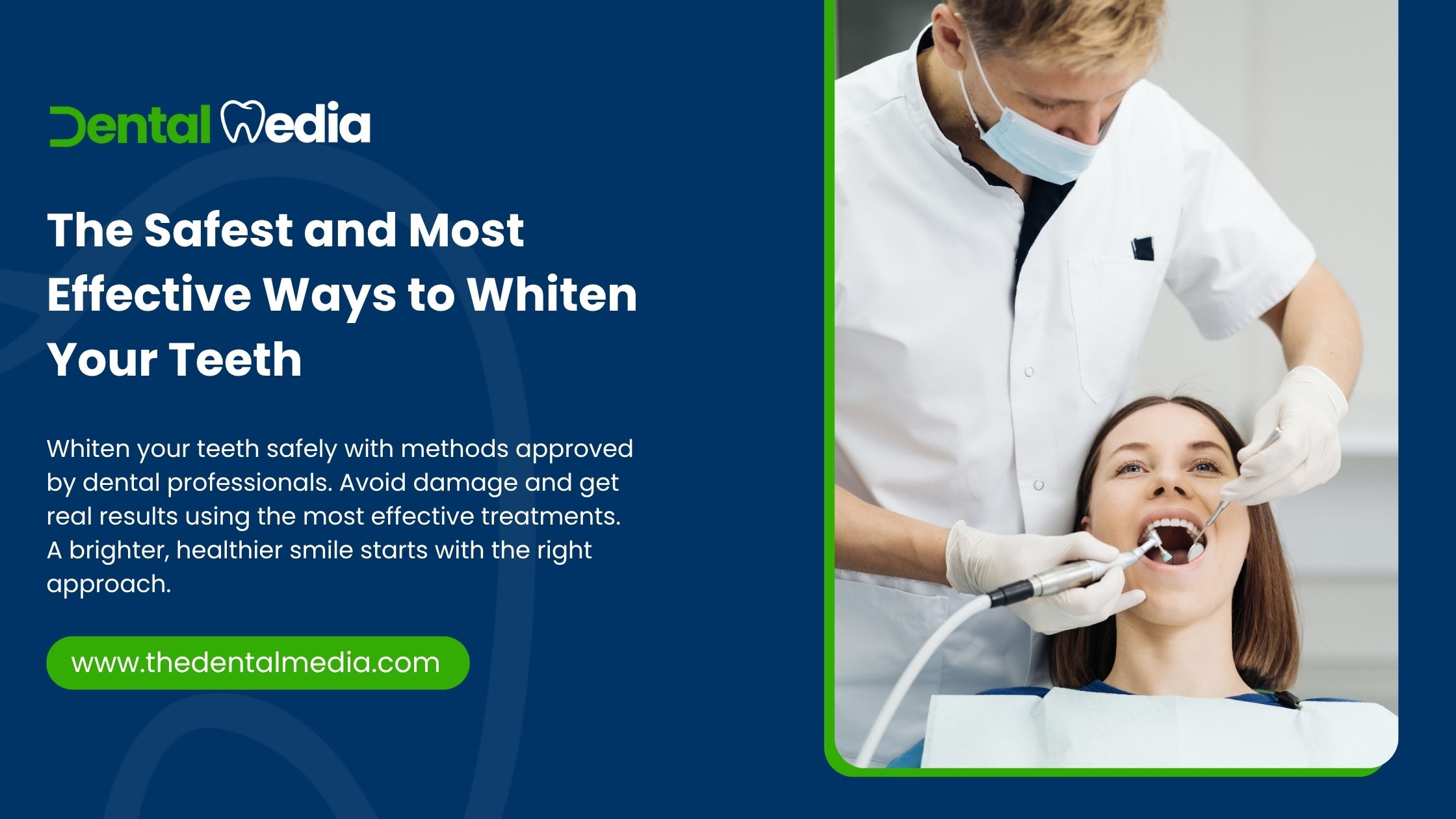A bright, white smile is often associated with good health, youth, and confidence. It’s no surprise that teeth whitening has become one of the most popular cosmetic dental procedures in the world. But with so many whitening products and methods out there—from whitening strips to charcoal powders—how do you know which ones are safe and truly effective to Whiten Your Teeth?
In this article, we’ll break down the safest and most effective ways to whiten your teeth, what to avoid, and how to maintain your results without damaging your enamel or irritating your gums.
What Causes Teeth to Stain?
Before we talk about whitening, it’s important to understand what causes teeth discoloration. Teeth can become stained due to:
- Extrinsic stains: These appear on the surface of the teeth, caused by foods, beverages (like coffee, tea, red wine), tobacco, or poor oral hygiene.
- Intrinsic stains: These develop inside the tooth and can be caused by aging, trauma, medications (like tetracycline), or excessive fluoride exposure during childhood.
Extrinsic stains are usually easier to whiten, while intrinsic stains may require more advanced treatments.
The Safest & Most Effective Teeth Whitening Options
1. Professional Teeth Whitening (In-Office Treatment)
Effectiveness:
Safety: High (When performed by a dentist)
Professional whitening treatments done at your dentist’s office are the fastest and most effective way to get visibly whiter teeth—often in just one visit. These treatments use stronger concentrations of bleaching agents like hydrogen peroxide or carbamide peroxide, which penetrate the enamel to break down stains.
Benefits:
- Immediate results (can whiten teeth by several shades)
- Performed under professional supervision
- Reduced risk of gum irritation or enamel damage
Downsides:
- More expensive than at-home options
- Temporary sensitivity may occur
Best for:
Anyone looking for fast, dramatic results in a safe and controlled setting.
2. Dentist-Prescribed Take-Home Whitening Kits
Effectiveness:
Safety: High
These kits are custom-made by your dentist with whitening trays designed to fit your teeth precisely. They contain a lower concentration of peroxide than in-office treatments but are stronger than over-the-counter products.
Benefits:
- Effective and safe for long-term use
- Custom-fit trays reduce risk of uneven whitening or gum irritation
- Can be used over several days/nights for gradual results
Downsides:
- Takes longer than in-office treatment
- Still more expensive than drugstore products
Best for:
Patients who prefer whitening at their own pace with professional guidance.
3. Over-the-Counter (OTC) Whitening Strips & Gels
Effectiveness:
Safety: Moderate
Whitening strips and gels are widely available and relatively affordable. They usually contain a mild peroxide-based solution and can whiten teeth over a few weeks.
Benefits:
- Convenient and accessible
- Noticeable results with consistent use
Downsides:
- Results vary depending on the product and user
- Risk of overuse, which can cause tooth sensitivity or gum irritation
- May not reach all areas of the teeth
Best for:
Those with mild surface stains and looking for a budget-friendly option.
4. Whitening Toothpaste and Mouthwash
Effectiveness:
Safety: High
These products don’t actually “bleach” your teeth, but they help remove surface stains using mild abrasives or polishing agents. Some contain small amounts of hydrogen peroxide.
Benefits:
- Safe for daily use
- Affordable and easy to incorporate into your routine
Downsides:
- Minimal whitening effect
- Can take weeks or months to notice a difference
Best for:
Maintaining whitening results or mildly improving tooth color over time.
5. Natural Remedies (e.g., Baking Soda, Oil Pulling, Activated Charcoal)
Effectiveness:
Safety: Varies
Baking soda has mild abrasive properties and can help polish teeth. Oil pulling with coconut oil may reduce bacteria, and activated charcoal is a trendy (but controversial) method.
Pros:
- Inexpensive and natural
- May help with plaque and surface stains
Cons:
- Limited scientific evidence for their effectiveness
- Some methods (like charcoal) may be too abrasive for enamel
- Not a substitute for professional whitening
Best for:
Supplementing oral care routines, but not as a primary whitening method.
Whitening Methods to Avoid
- DIY Hydrogen Peroxide or Lemon Juice Mixtures: These can erode enamel and damage your gums over time.
- Excessive Use of Abrasive Whitening Powders: These may wear down enamel, making teeth more sensitive and prone to decay.
- Non-Dental “Whitening Clinics”: Be cautious of places offering teeth whitening without a licensed dentist present. You risk burns, irritation, and permanent damage.
Tips for Maintaining a Whiter Smile
Once you’ve whitened your teeth, here’s how to keep them looking bright:
- Brush twice a day with a fluoride toothpaste
- Avoid stain-causing foods/drinks (or rinse with water after consuming them)
- Use a straw for dark beverages like coffee, tea, or soda
- Don’t smoke or use tobacco
- Visit your dentist regularly for cleanings
- Use whitening toothpaste or a whitening mouthwash for maintenance
Conclusion: What’s Right for You?
There’s no one-size-fits-all answer for teeth whitening. The safest and most effective method depends on your goals, budget, and oral health. If you’re looking for fast, dramatic results, professional in-office whitening is the best option. If you prefer a gradual, convenient approach, a dentist-prescribed take-home kit may be ideal. For minor touch-ups or maintenance, over-the-counter products or whitening toothpaste can be helpful.
Always consult with your dentist before starting any whitening treatment—especially if you have sensitive teeth, dental restorations (like crowns or veneers), or underlying oral health issues.
Need Help Choosing the Right Whitening Option?
If you’re unsure about which teeth whitening method is best for you, contact us at The Dental Media. Our dental experts are here to guide you to a brighter, healthier smile—safely and effectively.

